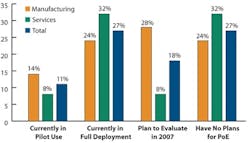PoE Technology Charges Into Networks
Less than 24% of industrial network developers at manufacturing companies consider their power-over-Ethernet (PoE) initiatives fully deployed, according to survey data from Information Resources, a Beverly, Mass., market research firm specializing in PoE.
The 2007 data indicates that 45% of respondents have plans to evaluate, pilot or implement PoE. “Power over Ethernet is in its formative years,” says Marianne D’Aquila, founder and analyst at Information Resources. “To date, the technology has found its primary market with WLAN and VoIP implementation and will continue to grow with these markets. Users are open to examining PoE with additional applications, particularly as PoE Plus enables more power across the Ethernet cable.”
PoE Plus is necessary to move the technology from its niche to mainstream by offering the promise of higher power for a greater number of powered devices, says D’Aquila. Ethernet-switch vendors are embracing PoE by trending toward offering PoE-enabled switches as a standard option. Users who consider themselves in full deployment also will revisit PoE as new applications become more mainstream, according to the survey.
The market for PoE-related products has been growing at a double-digit rate, says D’Aquila, who also predicts the major Ethernet-switch vendors are embracing PoE and will continue to trend toward offering PoE ports as a standard option.
This is important for several reasons, she explains. “First, IT integrators will have the necessary hardware required to provide PoE to new powered devices as they come to market,” says D’Aquila. “Second, semiconductor vendors who are providing PSE IC solutions can find significant opportunities here. Third, PoE Plus will demand even more power and will force power architecture changes and possibly fundamental infrastructure changes at the switch level.”
Which of the following describes your use or state of PoE deployment?
Source: Information Resources
UPS manufacturers see opportunities to work with switch vendors to tackle the challenges of power and heating, observes D’Aquila, but vendors of PoE technology can benefit greatly by helping users understand the cost benefits and flexibility of PoE.
“Budgets remain modest for PoE-specific expenditures, but this should not be discouraging because PoE is becoming more integrated in PSE and PD equipment which might result in the lack of specified budgets,” she says.
“The ratification of the PoE Plus standard is an important milestone for PoE technology,” emphasizes D’Aquila. “The simultaneous increase in power capability with reduced power consumption for pervasive technologies offers tremendous growth opportunities for PoE. Vendors who can convey clear ROI models combined with technological expertise will garner the surest path to market leadership.”



